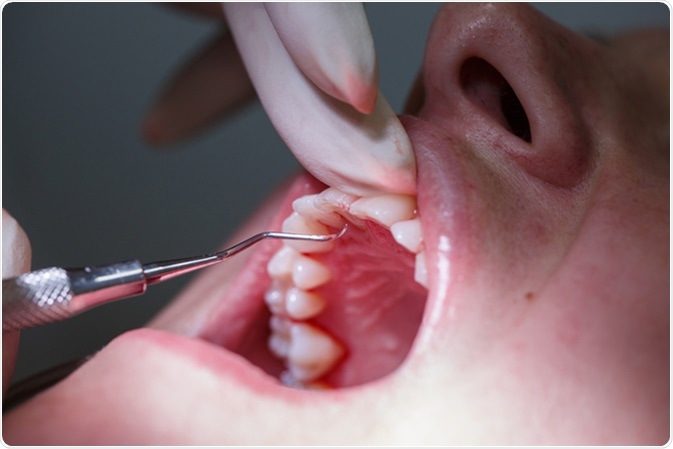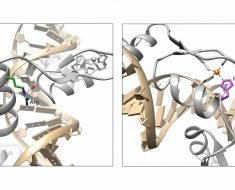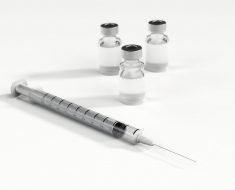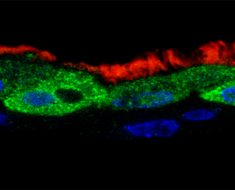Periodontitis, or periodontal disease, is an infection of the structures in the mouth that surround the teeth, such as the gums, periodontal ligament, alveolar bone, and cementum at the root of the tooth. There are many possible causes of periodontitis, which will be described in more detail in this article.

Bacteria in Dental Plaque
The primary cause of periodontitis is bacteria in dental plaque. Dental plaque, which is a mix of the bacteria, mucus and other particles, forms and settles on and around the teeth. The immune system attempts to eradicate the bacteria, which can lead to inflammation in the area and can potentially cause damage to the gums, periodontal ligament, alveolar bone, and cementum.
Brushing and flossing the teeth regularly helps to remove plaque but it soon starts to build up once again after they have been cleaned. Therefore poor oral hygiene is associated with the development of periodontitis.
Gingivitis
Plaque around the teeth that has not been removed can sometimes harden to form tartar. Tartar cannot be removed easily with brushing and, instead, a professional cleaning at the dentist is required. When plaque and tartar remain on the teeth and gums for a long time, they can cause significant damage to the gums.
Patients may report red, swollen and bleeding gums, which is characteristic of gingivitis, the earliest stage of periodontal disease when only the gums are affected. Gingivitis can usually be reversed with regular cleaning of the teeth by brushing, flossing and dental cleaning.
Gingivitis that has not been adequately treated can progress to periodontitis, which involves inflammation of the tissue surrounding the teeth. In this case, the gums can be pulled back from the teeth, forming little pockets that can easily become infected.
The immune system works to eradicate the bacteria from the area. This can result in the release of chemicals, in addition to bacterial toxins, that can lead to degradation of the bone and connective tissue that support the teeth and hold them in place. In severe cases, the teeth may be destroyed or fall out.
Risk Factors
There are several risk factors that increase the risk that an individual will be affected by periodontal disease. These may include:
- Smoking: Smoking can increase the risk of a bacterial infection forming in the mouth and also make periodontitis more difficult to treat.
- Hormonal changes in women: Females who have had recent changes in their hormones due to puberty, pregnancy or menopause are more likely to be affected by periodontitis.
- Genetic susceptibility: Some people are more likely to be affected than others due to their genetic makeup.
- Medications: Treatments for several health conditions, including AIDS and cancer may increase the risk of periodontitis. Additionally, medications that have a reduced flow of saliva as an adverse effect (e.g. phenytoin, cyclosporine, nifedipine) may be associated with the condition due to the absence of the natural protection that saliva provides to the teeth and gums.
- Age: Elderly people are more likely to be affected.
Associated Health Conditions
There are several health conditions that have been linked to the occurrence of periodontitis. These seem to have an increased incidence in patients with the disease. These include:
- Heart disease: Periodontitis may increase the risk of atherosclerosis and heart disease, or worsen existing disease. Likewise, it may also increase the risk of ischemic stroke.
- Premature birth: Pregnant women with periodontitis are more likely to have a premature baby or an infant with low birth weight.
- Diabetes: People with both diabetes and periodontal disease are more likely to have difficult maintain healthy blood sugar levels. Additionally they are more likely to develop infections such as periodontitis.
- Respiratory conditions: Periodontitis may cause or worsen symptoms of lung conditions such as COPD or asthma. Additionally, it can increase the risk of pneumonia.
References
- https://medlineplus.gov/ency/article/001059.htm
- http://www.colgate.com/en/us/oc/oral-health/conditions/gum-disease/article/what-is-periodontal-disease
- https://www.nidcr.nih.gov/OralHealth/Topics/GumDiseases/PeriodontalGumDisease.htm
- http://www.efp.org/patients/what-is-periodontitis.html
- http://www.deardoctor.com/articles/understanding-gum-periodontal-disease/index.php
- http://www.mayoclinic.org/diseases-conditions/periodontitis/symptoms-causes/dxc-20315543
Further Reading
- All Periodontitis Content
- What is Periodontitis?
- Prevention of Periodontitis
- Management of Periodontitis
- Periodontitis and Pregnancy
Last Updated: Feb 27, 2019

Written by
Yolanda Smith
Yolanda graduated with a Bachelor of Pharmacy at the University of South Australia and has experience working in both Australia and Italy. She is passionate about how medicine, diet and lifestyle affect our health and enjoys helping people understand this. In her spare time she loves to explore the world and learn about new cultures and languages.
Source: Read Full Article





